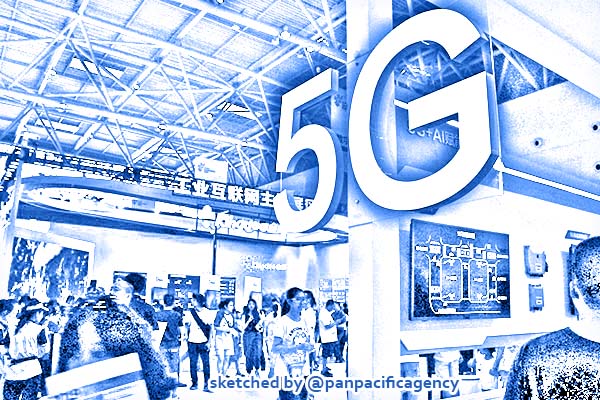[Analytics] Singapore kickstarts 5G era, likely to run on Nokia, Ericsson networks

A 5G display at the Smart China Expo. Photo: AP. Sketched by the Pan Pacific Agency.
Singapore’s mobile operators are preparing to deploy their nationwide 5G networks, having now completed the required regulatory procedures and officially securing their licences. Eileen Yu specially for the ZD Net.
Singtel has opted to work with Ericsson while joint licensees StarHub and M1 have gone with Nokia to build out their core 5G infrastructures, but all three telcos say they will collaborate with others such as Huawei and ZTE on various use cases.
Industry regulator Infocomm Media Development Authority (IMDA) on Wednesday said it had finalised the issuing of the country’s two nationwide 5G licences after the telcos completed a series of regulatory processes, including the selection of their preferred frequency spectrum lots, vendor partner,s and other technical and legal matters. The licensees also fulfilled other requirements such as network rollout and performance, coverage, resilience, cybersecurity, and vendor diversity.
IMDA added that it also awarded TPG Telecom the remaining frequency spectrum in the millimetre wave band, which would enable the Australian telco to roll out localised 5G networks. The telco as well as mobile virtual network operators would have to negotiate wholesale service agreements with Singtel or M1 and StarHub to tap their respective 5G networks, in order to offer retail 5G services to end-users.
Singapore’s Minister for Communications and Information S. Iswaran said: “[The final 5G licences award] sets the stage for the development of a world-class, resilient, and secure 5G infrastructure, which will be the backbone of Singapore’s digital economy. We remain on track for nationwide 5G standalone deployment by 2025.”
The government last year unveiled several initiatives aimed at driving the development and adoption of 5G technology, including a S$40 million (US$29.53 million) pot to build up the supporting ecosystem. It also earmarked key verticals such as smart estates, urban mobility, and maritime, for their potential to showcase 5G use cases that could be championed globally.
IMDA added that it was launching 5G Living Lab@PIXEL in September 2020 to support industry efforts to develop 5G applications and help build up technical capabilities in the sector. Businesses would be able to develop and test 5G-enabled devices and applications via the Living Lab@PIXEL’s ecosystem of startups, it said.
Meanwhile, all three telcos said Wednesday they would be looking to deliver faster data speeds, lower latency, and new digital services with their 5G networks.
StarHub said it was finalising its contract terms with Nokia, its “preferred 5G technology partner”, to deploy its 5G radio access network for its core standalone 5G infrastructure as well as mmWave networks for localised 5G deployment. It noted, though, that it was “exploring other network elements” with vendors such as Nokia, Huawei, and ZTE.
The Singapore telco said it would be looking to tap its 5G network to deliver better response times, more secure transmission, and new digital services and applications such as augmented and virtual reality live feeds, artificial intelligence-powered applications such as facial recognition services, as well as advanced IoT (internet of Things) such as robots, drones, and autonomous vehicles.
M1 said it would work with several vendors including Ericsson, Nokia, and Huawei for the deployment of its mmWave localised networks, based on “specific use case requirements”.
The telco recently announced it was working with Airbus to pilot the use of 5G to operate unmanned aerial vehicles in real-world environments. The two partners would collaborate alongside IMDA and Maritime and Port Authority of Singapore (MPA) to conduct the coastal trials, which would run on M1’s 5G standalone network at the Singapore Maritime Drone Estate.
M1 CEO Manjot Singh Mann said: “We are already witnessing 5G’s transformational role in various sectors, such as the manufacturing, maritime, and F&B industries. Coupled with further cutting-edge technology, 5G will be the backbone and drive the next bound of Singapore’s digital economy, reinforcing its position as the region’s technology and connectivity hub.”
Singtel in its statement Wednesday said it would begin negotiations with Ericsson to roll out its core standalone 5G and mmWave networks. The telco also had been running 5G trials in manufacturing and port operations, involving drones, and cloud-based games.
The telco said it had been running testbeds with various technology vendors and local government agencies, including working with the port operator PSA to develop 5G use cases such as drones and crane automation at the Pasir Panjang Terminal.
Singtel Group CEO Chua Sock Koong said: “This licence is also very timely in light of COVID-19 and the ensuing reliance on robust infrastructure and connectivity. Our existing network capabilities have allowed us to pivot quickly to the needs of the public and businesses at this critical time and 5G will help extend and accelerate the digital adoption we’ve witnessed, as we navigate our way out of COVID-19 towards recovery.”
In its statement Wednesday, TPG confirmed it secured 5G mmWave spectrum rights in 26GHz and 28GHz bands, which it said would enable it to tap the wider network and device ecosystem for its 5G deployment.
The Australian telco had submitted a bid for the nationwide licence, but failed to secure one. On IMDA’s decision in awarding the licences, Iswaran then had said the final process was dependant on the telcos’ compliance of what they had put into the CFP (Call For Proposal) proposal as well as whether they satisfied the regulatory requirements in terms of resilience and security. The minister’s comments were in response to questions on whether TPG had lost out on the nationwide 5G licence because it had opted to run completely on Huawei equipment. He had noted that the other telcos, too, had been using Huawei’s products.